*NURSING > QUESTIONS & ANSWERS > Clin Nurse Leader Exam Questions and answers. 99% Approved pass rate. Graded A+ (All)
Clin Nurse Leader Exam Questions and answers. 99% Approved pass rate. Graded A+
Document Content and Description Below
Gap Analysis - ✔✔Compares ACTUAL performance with POTENTIAL/desired performance Evaluates the strengths and weaknesses of the team in relation to required outcomes A good tool for analysis... to gain better understanding of the team's functioning 3 phases of knowledge transfer when using EBP - ✔✔1. Knowledge creation and distillation (research and recommendations for clinical practice) 2. Diffusion and Dissemination (distribute info to users, partner with organizations like professional nursing orgs) 3. Implementation and Institutionalization (end user adoption - health care systems adopt practices) Examples of restraining forces in Lewin's Change theory - ✔✔work against the driving forces to inhibit change example: want to quit smoking but live with people who smoke so hard to quit in that living situation Examples of driving forces for Lewin's change theory - ✔✔factors that support change or push patient towards necessary changes such as the drive to quit smoking to breathe easier Peplau's Theory of Interpersonal Relations - ✔✔focuses on relationship between patient and nurse 4 phases: 1. Orientation - seeks help through appts, treatment, etc. for RN to determine patients need for assistance 2. Identification - help identify who can help, set goals of care 3. Exploitation - receives care from rN 4. Resolution - care is completed Total patient care. - ✔✔One nurse is responsible for planning, organizing and delivery of care to a particular client or group of clients during the assigned shift Primary nursing - ✔✔a method of care in which the same RN assigned to same patient over time; assumes 24 hour responsibility for planning, directing, and evaluating client care from the time of admission through discharge team nursing - ✔✔a nursing care pattern; a team of nursing staff is led by an RN who decides the amount and kind of care each person needs - each member responsible for certain cares such as ADLs or meds Each team member is able to contribute their own special expertise or skills caring for the client Continuity of care may suffer if daily assignment of team varies and client is exposed to many different caregivers. relative risk - ✔✔used when the study involves comparing the likelihood, or chance, of an event occurring between two groups ratio of the absolute risk of a disease among the exposed group to the absolute risk of the disease among the unexposed group in an epidemiologic study confidence interval - ✔✔the range of values within which a population parameter is estimated to lie based on a random sample of the population. The most common interval is the 95% confidence interval. It represents the range that one can be 95% confident that the population parameter lies. confounding - ✔✔distortion in the degree of association because researcher failed to control, or eliminate the confounding variable, damaging the internal validity of an experiment. occurs when two variables are associated in such a way that their effects on a response variable cannot be distinguished from each other internal validity - ✔✔extent to which a piece of evidence supports a claim about cause and effect & degree to which the results of a study are not due to bias or confounding External validity - ✔✔the degree to which the results of the original study are applicable to a population other than the one initially targeted = generalizability An oral glucose tolerance test (OGTT) measures - ✔✔your blood sugar after you have gone at least eight hours without eating and two hours after you drink a glucose-containing beverage. This test can be used to diagnose diabetes or prediabetes. Oral Glucose Tolerance Test (OGTT) result of 150 means what? A. Based on a value greater than 140 mg/dL, the patient should have 3-hour 100-g OGTT within 1 week. B. The results are within normal limits and do not meet the threshold for the diagnosis of gestational diabetes. C. A fasting blood sugar should be checked as soon as possible. D. Based on this abnormal value, the 3-hour OGTT is not required. - ✔✔A. Based on a value greater than 140 mg/dL, the patient should have 3-hour 100-g OGTT within 1 week. Rationale: If your blood glucose is higher than 140 mg/dL, the next step is the oral 3-hour glucose tolerance test. This test will determine if you have gestational diabetes. After performing the literature review and developing a PICOT question, what should you do next before implementation? A. Form a team of stakeholders B. Develop a comparison group C. Talk to the manager D. Start the implementation process - ✔✔A. Form a team of stakeholders Rationale: After performing the literature review and developing a PICOT question, you should create a team of stakeholders to ensure the intervention has the appropriate resources to make the study successful. Pt has a blood sugar of 58 with headache and blurry vision. Which of the following interventions is appropriate for the nurse to tell the CNL? A. The patient is experiencing hyperglycemia and should be given a protein snack. B. The patient is experiencing hyperglycemia and should be given insulin and 1 cup of milk. C. The patient is experiencing hypoglycemia and should be given insulin and 1 cup of orange juice. D. The patient is experiencing hypoglycemia and should be given 1 cup of skim milk. - ✔✔D. The patient is experiencing hypoglycemia and should be given 1 cup of skim milk. Rationale: The patient's fasting blood sugar is below 60 mm/dL and is symptomatic. She must be treated for hypoglycemia by drinking 1 cup of skim milk, or 1⁄2 cup of juice, or 1⁄2 cup of soft drink. As a trial CNL, whose buy-in will be the most important in fully implementing the CNL role in the hospital? A. The chief nursing officer (CNO) B. The unit manager C. The members of the interdisciplinary team D. The staff affected by your outcomes - ✔✔The chief nursing officer (CNO) CNO will have the most influence in your hospital Orem's self care deficit theory - ✔✔The nurse's actions are directed toward assisting the patient to assume responsibility for self-care & based on the premise that all individuals are capable of self-care 1st step: identifying and prioritizing the client's unmet self-care needs (deficits). 2nd step: selecting methods of assisting the client to compensate for or overcome his self-care deficits. Leininger's Culture Care Theory - ✔✔Theory of cultural care diversity and universality - Integrates patients' cultural traditions, values and beliefs into care plans Care fits with or have beneficial meaning and health outcomes for people of different or similar culture backgrounds. similar to transcultural nursing (CPOE) Computerized physician order entry - ✔✔Feature of the EHR that assures standardized, legible communication of the medical plan of care to other members of the healthcare team Helps prevent errors (HIE) health information exchange - ✔✔Allows for multiple health care organizations serving a client to share health information across electronic networks , allows for timely access to client information for providers Although have to be careful with protected health information/HIPAA perceived conflict (felt conflict) - ✔✔perceive that their situation is characterized by incompatibility and interdependence mistrust, hostility, and fear; misunderstanding each other or jumping to conclusions based on limited information Negotiating Conflict Style - ✔✔Resolve the conflict through assertive give and take concessions to deal or bargain with another - seeks agreement but not necessarily consensus; solution is rather permanent; revenue budget - ✔✔A budget that lists forecasted and actual revenues of the organization A projection of expected income for a budget period based on volume and mix of patients, rates, and discounts. Zero-based budgeting (ZBB) - ✔✔a method of budgeting in which managers thoroughly reevaluate organizational activities to determine their true level of importance ( all expenses must be justified for each new period) 5 rights of delegation - ✔✔1. Right task 2. Right circumstance 3. Right person 4. Right direction/communication 5. Right supervision accomodating conflict style - ✔✔cooperating in that one side gives in to the other side compromising conflict style - ✔✔each side gives something up and gains something; group members concede some goals in order to achieve other more important goals collaborating conflict style - ✔✔seeks joint resolution w/ best solution for all - develop optimal outcomes but does take a lot of time - requires commitment Confronting - ✔✔immediate and obvious movement to stop conflict at the very start Does not allow conflict to take root; very powerful. Conflict Management Strategies - ✔✔Avoidance Accommodation Competing Compromise Collaboration Negotiating Confronting Organizational conflict - ✔✔One person or a group vs an organization Example: competition for resources; Quality of patient care (nurse patient ratio) competing with COST interpersonal conflict - ✔✔conflict that occurs between two or more individuals or team to team intrapersonal conflict - ✔✔conflict that occurs within an individual ex. should I call in sick and attend my daughter's birthday party- I asked for the day off and didn't get it Overt behavior in conflict - ✔✔Behavior that is directly observed - aggression, competition, debate, or problem solving. covert behavior during a conflict - ✔✔a response that is internal or hidden from view - scapegoating, avoiding or apathy antecedent conflict conditions - ✔✔increase in conflict, incompatible goals, role conflict, structural conflict, competition for resources, differences in values and beliefs. phenomenlogical research - ✔✔inductive descriptive approach used to describe an experience as it is lived by an individual grounded theory research - ✔✔discover the problems that exist in a social scene and the process that persons involved use to handle them - how people define reality and how their beliefs are related to actions Change agent strategies - ✔✔Power-coercive: applies power from authority, economic sanctions, or political clout (e.g. don't text and drive or you'll get a ticket) Empirical-rational: assumes ppl are rational and will follow self-interest (e.g. don't text and drive or you will get hurt) Normative-reeducative: assumes ppl act in accordance with social norms and values (e.g. don't text and drive - "everyone's doing it') Justice - ✔✔fairness Values - ✔✔the ideas, beliefs, and attitudes about what is important that help guide the way you live Distributive Justice - ✔✔perceived fairness of the amount and allocation of rewards/goods among individuals in a society Bureaucratic leadership/Hierarchical leadership - ✔✔Hierarchy of authority - strictly follows set of rules/policies, assumes individuals are motivated by external factors Trusts neither followers or self to make decisions so relies on organizational policies and rules Clinical Decision Support (CDS) - ✔✔A set of patient-centered tools embedded within EHR software that can be used to improve patient safety, ensure that care conforms to published protocol for specific conditions, and reduce duplicate or unnecessary care and its associated costs Such as pop up reminders or alerts for interacting drugs address deficits in documentation; consider potential outcomes to their decision making, or as reminders to order screening tests Allocation focus of a policy means - ✔✔providing resources (income, services, goods) to ensure policy implementation Regulatory intent of policies focuses on - ✔✔prescribing and controlling behavior of particular population autocratic leadership - ✔✔leadership style that involves making managerial decisions without consulting others - leader makes all decisions and directs followers behavior authoritative control over group, assumes individuals are motivated by external forces, democratic leadership - ✔✔A form of leadership in which the leader solicits input from subordinates - consider employees opinions, suggestions, and concerns, - involves the whole group in decision making laissez-faire leadership - ✔✔allows the group to function more or less on its own, leaders are hand off Group members make own decisions - Lack of responsibility in leading Question: A staff nurse is curious about whether emptying the nasogastric (NG) suction canister is a task that can be delegated to a CNA. You, the CNL, guide her to what resource? A. The unit charge nurse B. Hospital policy/procedure manual C. The State Board of Nursing Scope of Practice D. The Joint Commission website - ✔✔The State Board of Nursing Scope of Practice Rationale: The most reliable source for what tasks may be delegated is the individual state's scope of practice. What p-value indicates a significant statistical finding in research? - ✔✔Less than 0.05 Transtheoretical Model of Change - ✔✔Prochaska and Diclemente's model to conceptualize the process of intentional behavior change Patients may spiral in and out of stages, forward and back Question: During the policy formulation phase, all of the following are correct except: A. Possible solutions are offered. B. Political circumstances are considered. C. A problem is identified. D. Policy decisions are adjusted to accommodate changing circumstances or needs. - ✔✔D. Policy decisions are adjusted to accommodate changing circumstances or needs. Rationale: Policy formulation is the development of effective and acceptable courses of action in order to address what has been placed on the policy agenda. This should include the following characteristics: (a) The problem is identified, (b) possible solutions are offered, (c) political circumstances are considered, and (d) policy makers, stakeholders, and legislative staff are involved. servant leadership - ✔✔focuses on increased service to others rather than to oneself Leading originates from a desire to serve, leader emerges when others' needs take priority focus on whether the least advantaged in society benefit from the leader's service Question: You are a CNL on an oncology unit. Recently, there has been an increase in the number of catheter- associated urinary tract infections (CAUTIs) on your unit. After shadowing nurses and aides you observed a variety of practices, techniques, and expectations surrounding daily catheter care. Your hospital does not have a current policy or procedure regarding catheter care. As the CNL, what should you do next? A. Review current evidence for catheter care practice and disseminate evidence to the staff B. Form an interdisciplinary team meeting to evaluate current hospital catheter care policies C. Create a rubric for educating patients and staff on catheter care D. Discuss with the unit manager the clinical issue and create a set of evidence-based unit expectations and practices for the oncology unit. Evaluate the need to address this issue with a hospital-wide policy or procedure - ✔✔Discuss with the unit manager the clinical issue and create a set of evidence-based unit expectations and practices for the oncology unit. Evaluate the need to address this issue with a hospital-wide policy or procedure Rationale: The CNL should act to solve the clinical issue in the short term, and evaluate the need for a larger policy to address gaps in practice hospital-wide. Hawthorne effect - ✔✔A change in a subject's behavior caused simply by the awareness of being studied - people act as expected when being watched, the act of research effects the outcome. Neoclassical Theory - ✔✔A modification of classical theory with human component believe in cooperation and participation, tapping into motivation of the individual Classical Organizational Theory - ✔✔An early approach to the study of management that focused on the most efficient way of structuring organizations - efficiency through design What are different organizational theories? - ✔✔1. classical 2. neoclassical 3. systems theory 4. contingency theory 5. chaos theory Contigency Theory - ✔✔Dependent on environment; performance can be enhanced by matching an organizational structure to its environment Optimal form of the organization is CONTIGENT upon the challenges and circumstances of the environment no one best way of leading, and that a leadership style that is effective in some situations may not be successful in others. Question: What organizational theory is used with rapid, unpredictable, and constant change? A. Systems theory B. Chaos theory C. Change theory D. Traditional theory - ✔✔Chaos theory quasi-experiment - ✔✔an experiment that estimates the causal impact of an intervention on target population WITHOUT random assignment Can be used to include pre and post measures/surveys Run chart - ✔✔tool for tracking results over a period of time - Line graph of data plotted over time Shows trends/patterns Question: A CNL in the emergency department (ED) is auditing stroke patients' charts and the administration of tissue plasminogen activator (tPA) and notices that only 83% of patients who are eligible to receive tPA are receiving it. The CNL knows that the 83% administration rate is below the national benchmark. The CNL identifies that there is a time lag in MRI. The CNL creates a stroke team to develop a guideline implementation action plan to improve the process of timing of the MRI. What is the best tool utilized by the CNL in implementing change? A. Research study B. Meta-analysis C. Plan-Do-Study-Act (PDSA) D. Standardize-Do-Study-Act - ✔✔Plan-Do-Study-Act (PDSA) Rationale: PDSA is a model for quickly and easily testing ideas that could lead to improvement, based on existing ideas, research, feedback, theory, reviews, audits, or evidence of what has worked elsewhere. Mesosystem - ✔✔Multiple similar microsystems in a division of the hospital ethnographic research - ✔✔the study of human behavior in its natural environment & promotes culturally sensitive care - obtain perspectives beyond own culture What are some examples of how you increase EBP into unit practice? - ✔✔-Ensure policies/procedures are based on recent literature -Journal Clubs -Nursing grand Rounds Group think - ✔✔the mode of thinking that occurs when the desire for harmony in a decision-making group overrides a realistic appraisal of alternatives Conflict resolution phenomenon when group members try to decrease conflict by reaching consensus too early without all ideas/consequences discussed Interferes with critical thinking Pareto Chart - ✔✔a bar chart on which factors are plotted to help identify top rates and guide a focus of primary issues - bar height reflects frequency or impact of causes (descending bars) help identify the causes that are likely to have the greatest impact on the problem if addressed - guide the process of selecting key, high impact improvements Some causes have a much greater effect on problem we want to address than others: "80% of the effects come from 20% of the causes" Question: A professor is discussing the difference between quantitative and qualitative research. As a CNL student, you are aware that quantitative research is related to numeric data with statistical analysis, while qualitative research focuses on non-numeric forms of research. Which of the following is an example of a quantitative study? A. Personal interviews B. Randomized controlled trial (RCT) C. Ethnography D. Phenomenology - ✔✔RCT Rationale: RCT is a quantitative research process that is a true experiment; it is the strongest design to support cause-and-effect relationships, in which subjects are randomly selected. Histogram Chart - ✔✔graphical representation of data Lewin's Change Model - ✔✔1. Unfreezing 2. Changing 3. Refreezing Question: Quality improvement (QI), as a function of the CNL role, is related to which core role competency of the CNL? A. Client advocacy B. Clinician C. Risk anticipator D. Team manager - ✔✔Risk anticipator Rationale: QI is a direct function of risk anticipation Flowchart - ✔✔A diagram that shows step-by-step progression through a procedure or system Maps out and helps visualize problem Fishbone chart - ✔✔used to aid in brainstorming and isolating the potential causes of a problem - Help identify root causes Cause and effect diagram Bounded Rationality Model - ✔✔According to this decision making model, individuals knowingly limit their options to a manageable set and choose the first acceptable alternative without conducting an exhaustive search for alternatives emphasizes limitations of rationality of the decision maker Question: A group composed of unit-based council members was put on a task force to improve the discharge planning process because patients felt unprepared and rushed at discharge. A decision was made to create a discharge planning nurse position to educate patients the night before the discharge. Even though the new nurses did not like this solution, they deferred to the senior nurses of this group who were adamant about implementing this position. Which barrier to effective teamwork does this exemplify? A. Physical threats B. Groupthink C. Team dysfunction - ✔✔B. Groupthink Rationale: Groupthink is a phenomenon that occurs when group members try to minimize conflict and reach consensus too early without fully vetting all ideas and consequences. Delphi Technique - ✔✔A decision-making technique in which group members do not meet face-to-face but respond to questions posed by the group leader systematically - ex. Survey monkey Transtheoretical Model of Change parts - ✔✔-Precontemplation -Contemplation -Preparation -Action -Maintenance Pender's Health Promotion Model - ✔✔health promotion activities to increase levels of well in that each person has unique personal characteristics/experiences that affect their choices of actions they have 1. individual experiences/characteristics that effect choice of action, 2. behavior specific thoughts, and 3. different believed outcomes/perceived benefits of anticipated outcomes Chaos Theory/Model - ✔✔Rapid changes, frequent The world is not orderly must adapt and change, be flexible Bioethical Decision Model - ✔✔10 step process in order to help with decisions in ethical dilemma Includes reviewing the situation, gathering information, identifying ethical issues, look at moral positions, identifying actions with outcomes, then deciding on action, and evaluating results Question: The CNL of the heart failure unit encourages the staff to earn advanced degrees, obtain certifications, and present and publish EBP projects. The CNL exhibits which type of leadership style? A. Relational leadership B. Transactional leadership C. Situational leadership D. Transformational leadership - ✔✔Transformational Leadership Rationale: A transformational leader motivates others to higher performance. Relational (Connective) Leadership - ✔✔A leadership style that values collaboration and teamwork; interpersonal skills are used to promote collegiality in achieving organizational goals Create positive relationships within the organization Situational Leadership Theory - ✔✔a leadership contingency theory that focuses on followers' readiness; adjust style to fit developmental level of followers trying to influence Fidelity - ✔✔principle of keeping one's promise or word veracity - ✔✔obligation to tell the truth According to the Diffusion of Innovation theory what 2 groups should you focus on when you want to have successful support for a change? - ✔✔Focus on the early and late majority adopters to support change for success as majority of the general population tends to fall in the middle categories Non-maleficence - ✔✔doing no harm beneficence - ✔✔to do good to others [Show More]
Last updated: 2 years ago
Preview 1 out of 38 pages
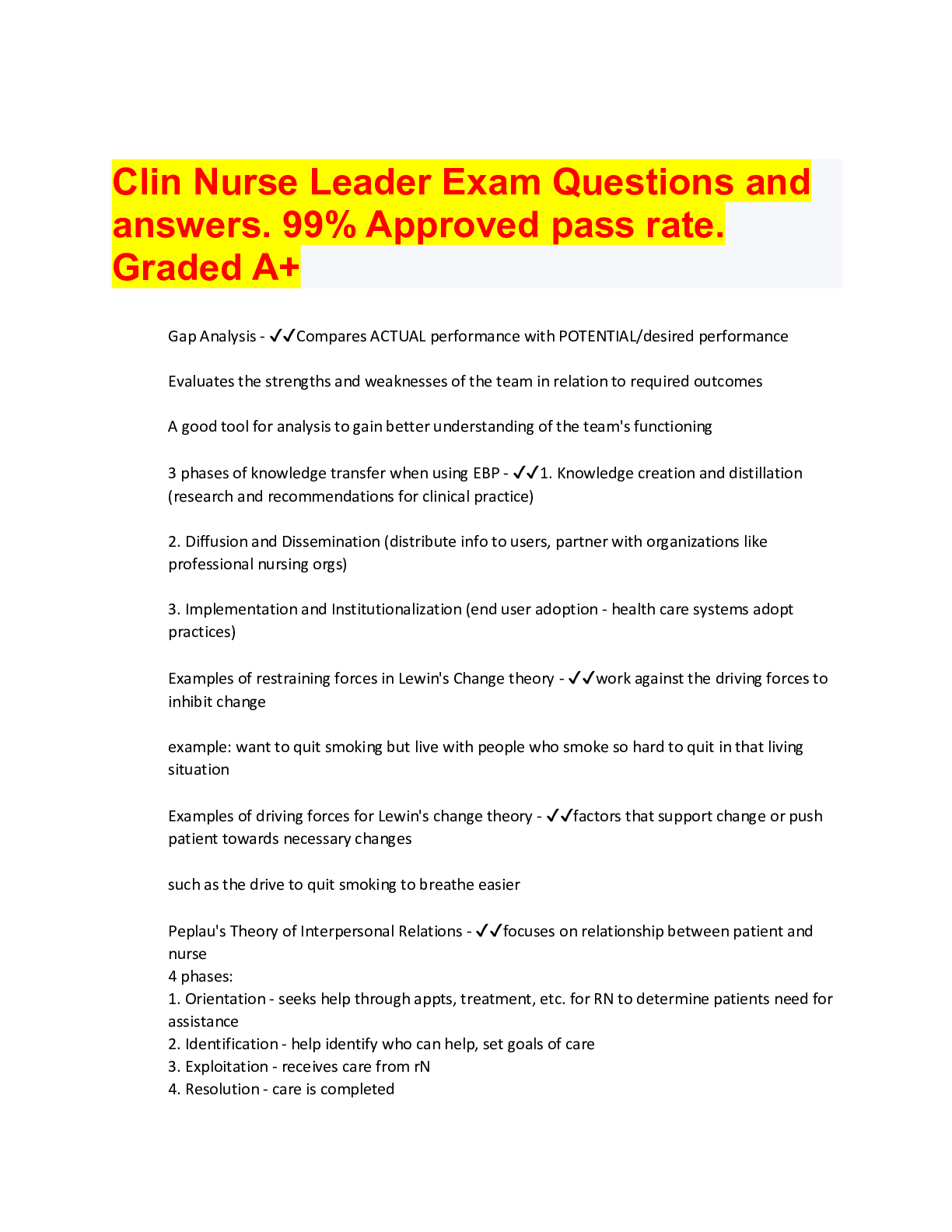
Buy this document to get the full access instantly
Instant Download Access after purchase
Buy NowInstant download
We Accept:

Also available in bundle (1)
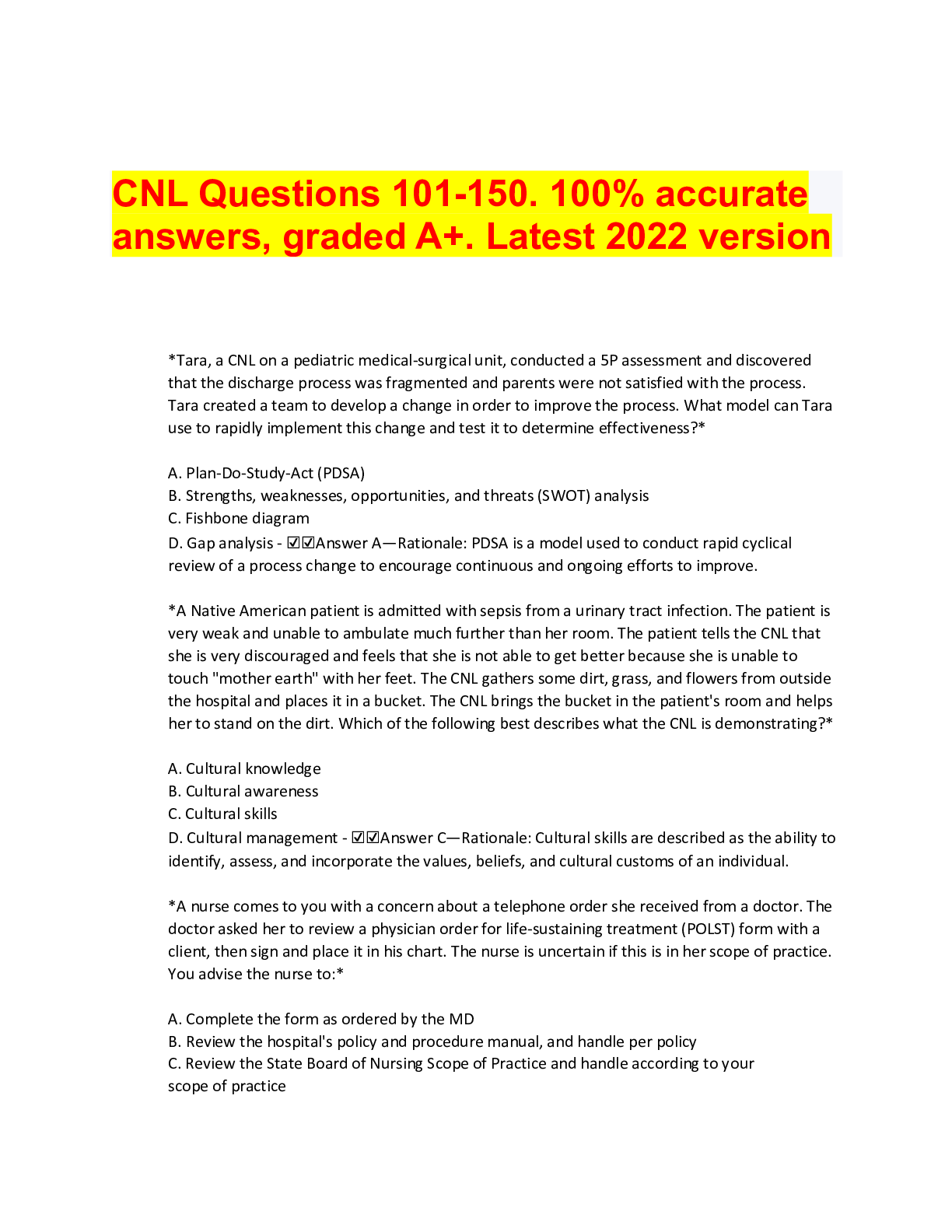
ALL CNL EXAM DOCUMENTS; QUESTIONS AND ANSWERS. PREDICTOR QUESTIONS. DOWNLOAD TO SCORE A+
Composed of 8 documents. All CNL questions and answers, latest versions 2022. rated A+
By bundleHub Solution guider 2 years ago
$28
8
Reviews( 0 )
$12.00
Can't find what you want? Try our AI powered Search
Document information
Connected school, study & course
About the document
Uploaded On
Aug 08, 2022
Number of pages
38
Written in
Seller

Reviews Received
Additional information
This document has been written for:
Uploaded
Aug 08, 2022
Downloads
0
Views
159











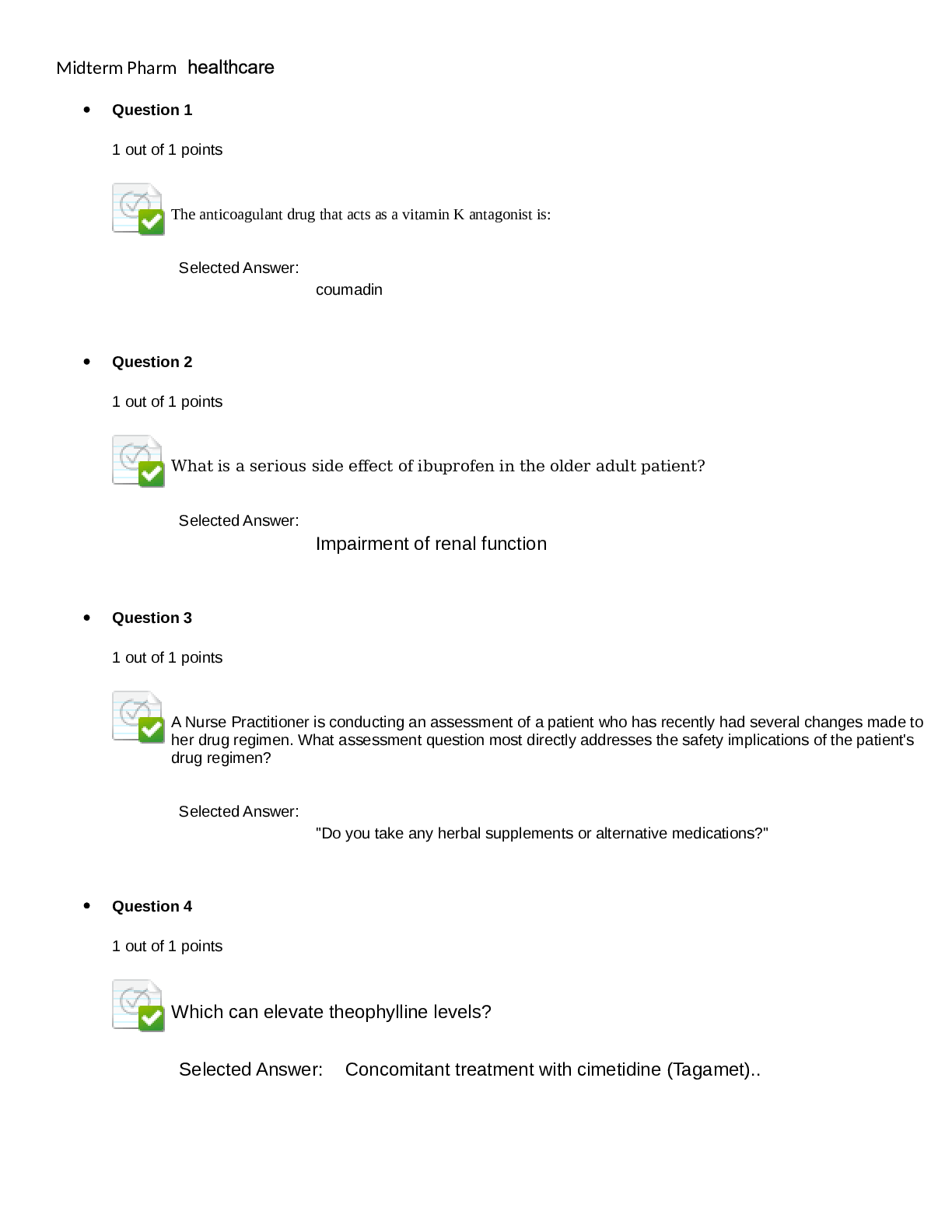

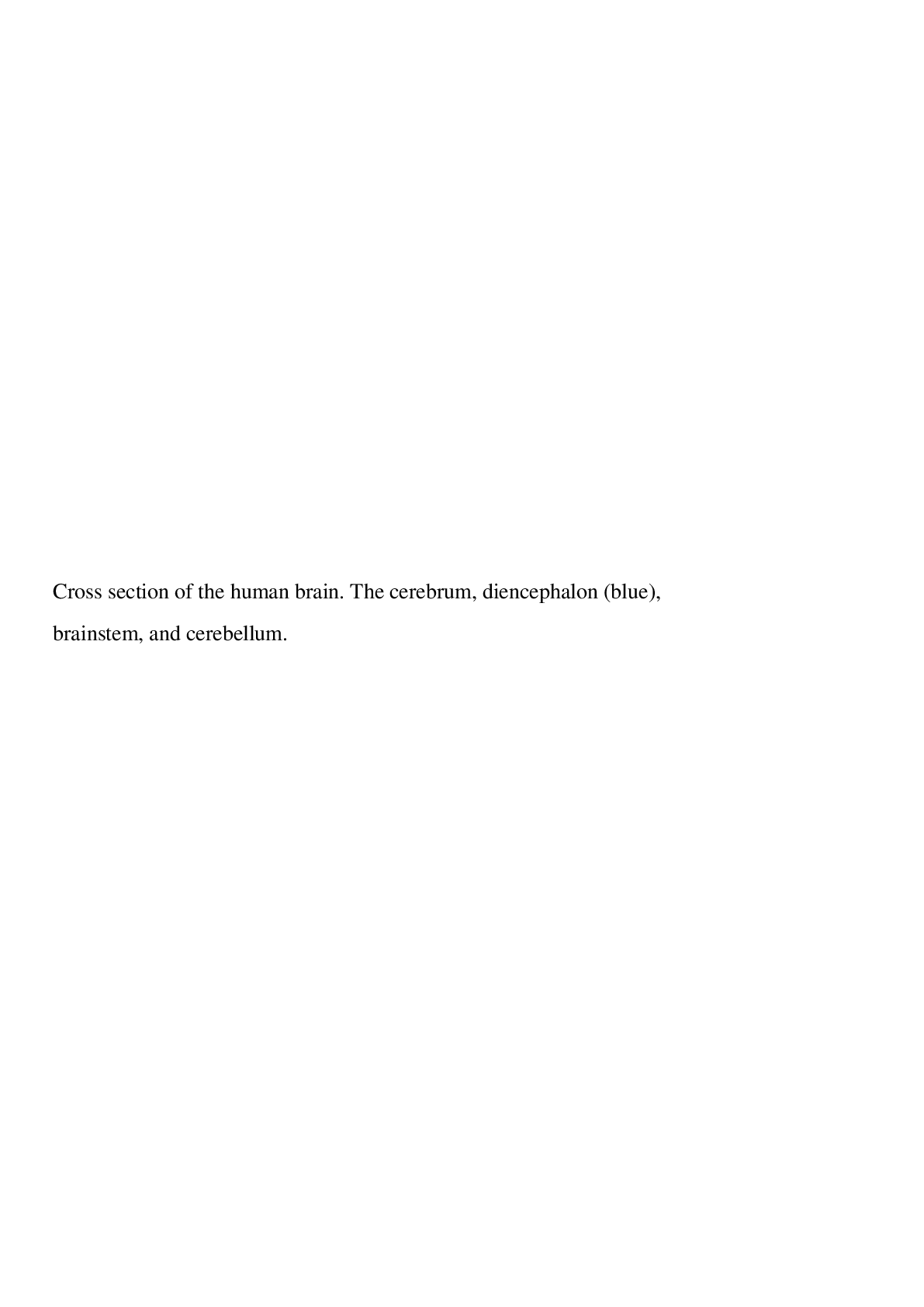


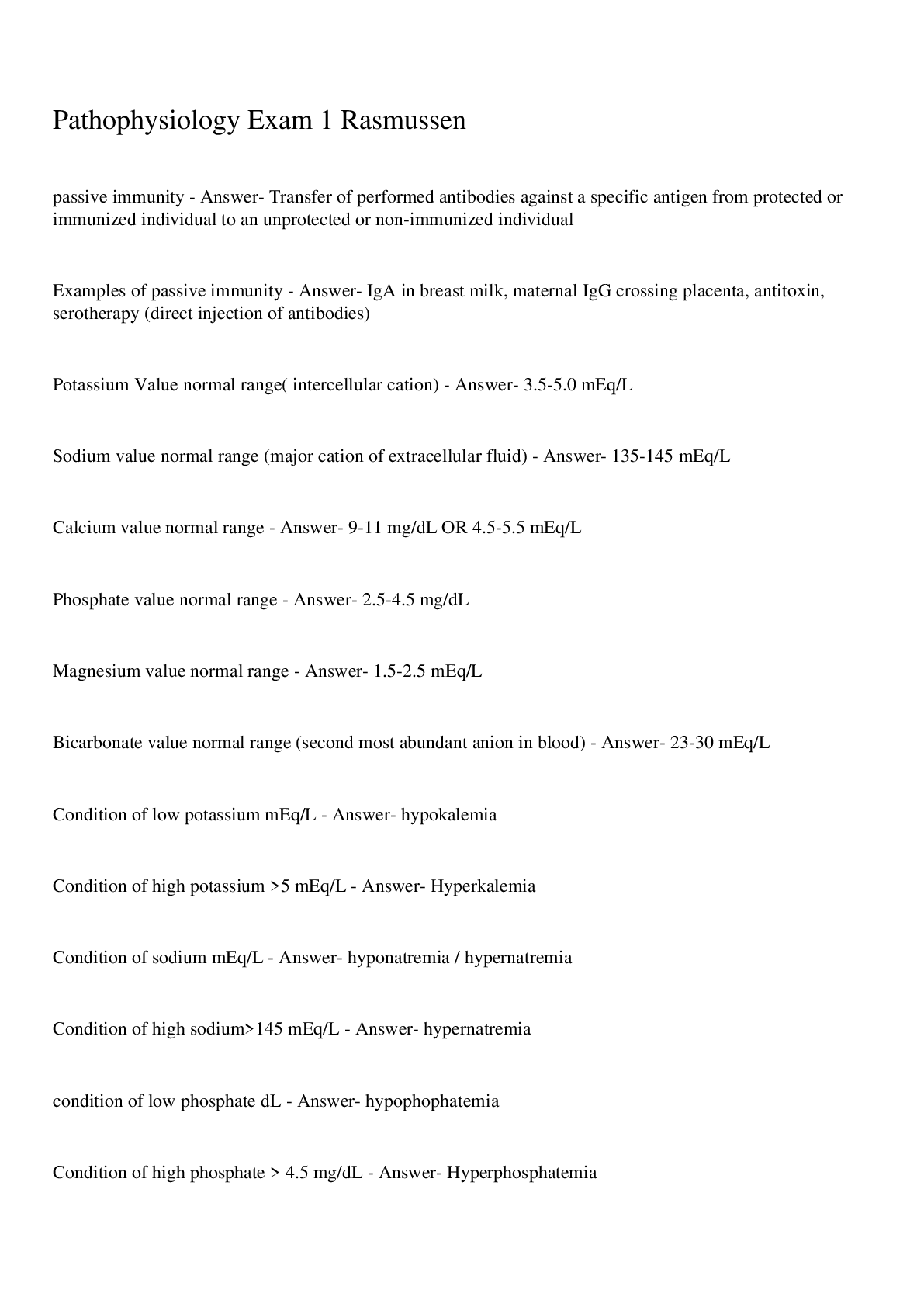


.png)


